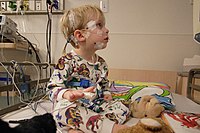
Photo from wikipedia
Background The underlying pathogenesis of pediatric obstructive sleep disordered breathing (SDB) and recurrent tonsillitis (RT) are poorly understood but need to be elucidated to develop less invasive treatment and prevention… Click to show full abstract
Background The underlying pathogenesis of pediatric obstructive sleep disordered breathing (SDB) and recurrent tonsillitis (RT) are poorly understood but need to be elucidated to develop less invasive treatment and prevention strategies. Methods Children aged between 1- and 16-years undergoing adenoidectomy, tonsillectomy or adenotonsillectomy for SDB (n=40), RT alone (n=18), or both SDB and RT (SDB+RT) (n=17) were recruited with age-matched healthy controls (n=33). Total bacterial load and species-specific densities of nontypeable Haemophilus influenzae (NTHi), Staphylococcus aureus, Streptococcus pyogenes, Streptococcus pneumoniae and Moraxella catarrhalis were measured by qPCR in nasopharyngeal swabs, oropharyngeal swabs, adenoid and tonsillar tissue from children with SDB, SDB+RT and RT, and in naso- and oro- pharyngeal swabs from healthy children. A subset of tonsil biopsies were examined for biofilms using 16S rRNA FISH (n=3/group). Results The 5 bacterial species were detected in naso- and oro- pharyngeal samples from all children. These species were frequently detected in adenotonsillar tissue (except S. aureus, which was absent in adenoids) from children with SDB, SDB+RT and RT. NTHi and S. aureus were observed in tonsils from 66.7-88.2% and 33.3-58.8% of children respectively. Similar total and species-specific bacterial densities were observed in adenotonsillar tissue from children with SDB, SDB+RT or RT. Nasopharyngeal and oropharyngeal swabs were more likely to have multiple bacterial species co-detected than adenotonsillar tissue where one or two targeted species predominated. Polymicrobial biofilms and intracellular bacteria were observed in tonsils from children with adenotonsillar disease. Conclusions Antimicrobials, particularly anti-biofilm therapies, may be a strategy for managing children with SDB.
Journal Title: Frontiers in Cellular and Infection Microbiology
Year Published: 2022
Link to full text (if available)
Share on Social Media: Sign Up to like & get
recommendations!